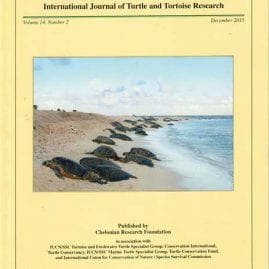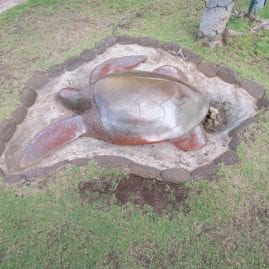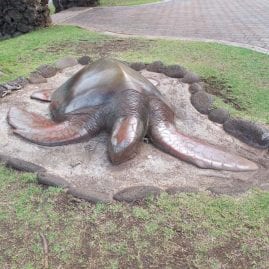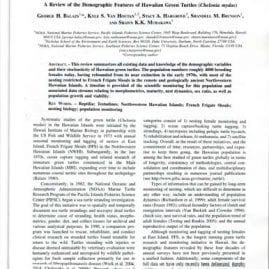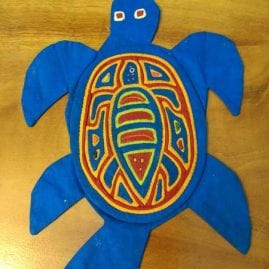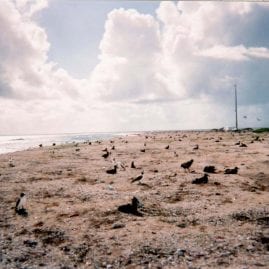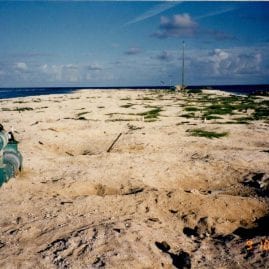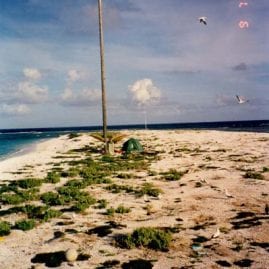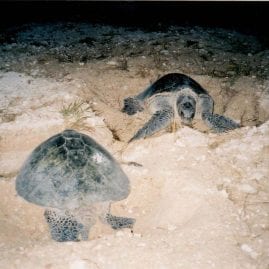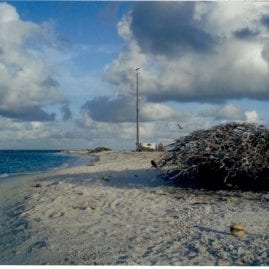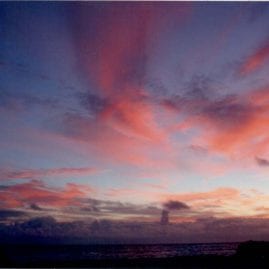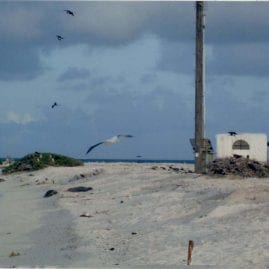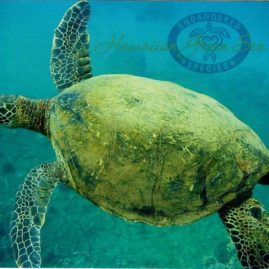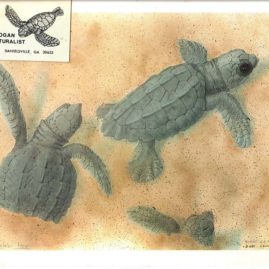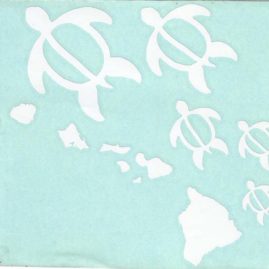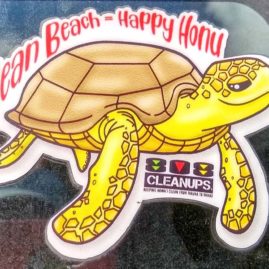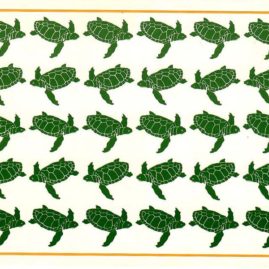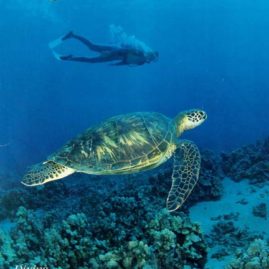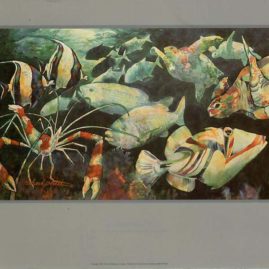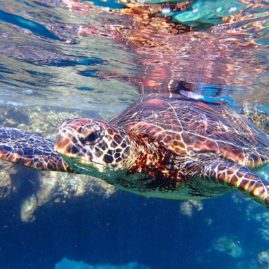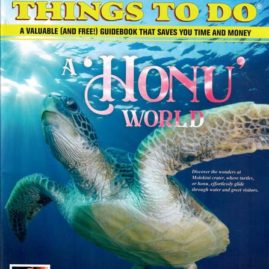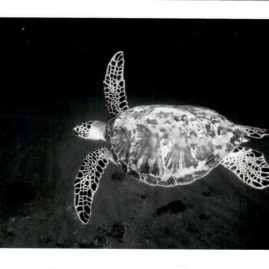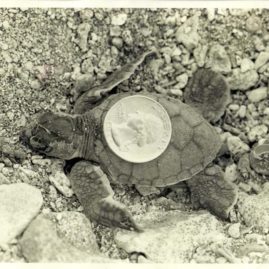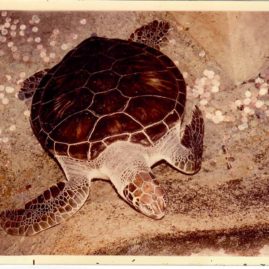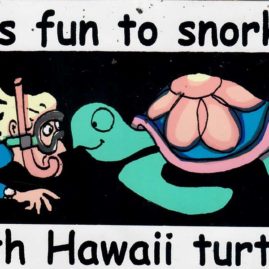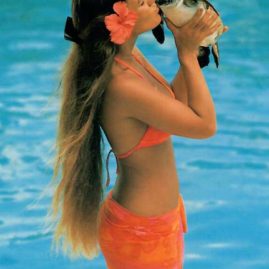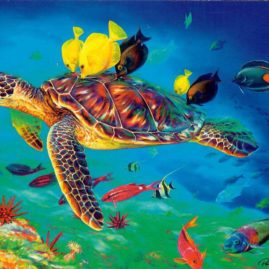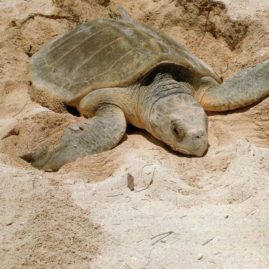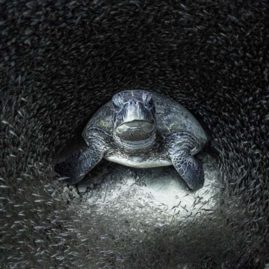Wabnitz, Balazs, Beavers, Bjorndal, Bolten, Christensen and Hargrove (2010) Ecosystem structure and processes at Kaloko Honokohau, focusing on the role of herbivores, including the green turtle in reef resilience. MEPS.
Tiwari, Balazs and Hargrove (2010) Estimating carrying capacity at the green turtle nesting beach of East Island, French Frigate Shoals. MEPS.
Bjorndal & Bolten (2010) Hawksbill sea turtles in seagrass pastures: Success in a peripheral habitat. MB.
Smith, Hunter and Smith (2010) The effects of top-down versus bottom-up control on benthic coral reef community structure.
Frey, Dutton and Balazs (2011) Insights into the nesting ecology of green turtles in the Main Hawaiian Islands derived from genetic analysis. ISTS-31
Snover, Hahn, Goshe and Balazs (2011) Validation of annual skeletal marks in green sea turtles using tetracycline labeling. Aquatic Biology.
Jones et al. (2011) Determining transmitter drag and best-practice attachment procedures for sea turtle biotelemetry. NOAA-TM-NMFS-SWFSC-480,
Russell, Hargrove and Balazs (2011) Marine sponges, other animal food, and nonfood items found in digestive tracts of the herbivorous marine turtle in Hawaii. Pacific Science.
Parker, Dutton and Balazs (2011) Ocean diet and distribution of haplotypes for the green turtle in the Central North Pacific. Pacific Science.
Snover, Balazs, Murakawa, Hargrove, Rice and Seitz (2012) Age and growth rates of Hawaiian hawksbill turtles using skeletochronology. MB.
Frey et al. (2012) Where are the green turtles in the Main Hawaii Islands coming from? ISTS-31.
Clarke, Balazs and Hargove (2012) Green sea turtles up and down the Anahulu River. ISTS-31 San Diego, California.
Bjorndal et al. (2012) Threshold to maturity in a long-lived reptile: Interactions of age, size, and growth. Marine Biology.
Shillinger et al. (2012) Tagging through the stages: technical and ecological challenges in observing life histories through biologging. MEPS.
Eguchi et al. (2012) Morphology and growth rates of green turtles in a northern temperate foraging ground. Herpetologica.
Jones et al. (2013) Calculating the ecological impacts of animal-borne instruments on aquatic organisms. MEE.
Davenport, Jones, Work and Balazs (2013) Unique characteristics of the trachea of the juvenile leatherback turtle faciliatates feeding, diving, and endothermy. JEMBE.
Jones and Seminoff (2013) Jones and Seminoff (2013) Feeding biology: advances from field-based observations, physiological studies, and molecular techniques. In: Biology of the Sea Turtles.
Pfaller et al. (2013) Accounting for imperfect detection is critical for inferring marine turtle nesting population trends. PLoS One.
Crespo et al. (2013) Two cases of pseudohermaphroditism in loggerhead sea turtles. DAO.
Frey, Dutton and Balazs (2013) Insights on the demography of cryptic nesting by green turtles in the main Hawaiian Islands from genetic relatedness analysis. JEMBE.
Francke et al. (2013) Behavior of juvenile green turtles in a coastal neritic habitat: Validating time-depth-temperature records using visual observations. JEMBE.
Moyle (2013) Conservation that's more than skin-deep: Alligator farming. Biodivers. Conserv.
Work and Balazs (2013) A simple humane method to euthanize a sea. Marine Turtle Newsletter.
Pfaller, Alfaro-Shigueto, Balazs, Ishihara, Kopitsky, Mangel, Peckam, Bolten & Bjorndal (2014) Hitchhikers reveal cryptic host behavior: new insights between Planes major and sea turtles in the Pacific Ocean. Marine Biology.
Heithaus et al. (2014) Seagrasses in the age of sea turtle conservation and shark overfishing. Frontiers in Marine Science.
Dutton et al. (2014) Population structure and phylogeography reveal pathways of colonization by a migratory marine reptile in the central and eastern Pacific.
Dutton et al. (2014) Genetic stock structure of green turtle nesting populations across the Pacific Islands. Pacific Science.
Parker, Balazs, Rice and Tomkeiwicz (2014) Variability in reception duration of dual satellite tags on sea turtles tracked in the Pacific Ocean. Micronesica.
Parker et al. (2014) First use of a GPS satellite tag to track a post-nesting hawksbill in the Hawaiian Islands with an indication of possible mortality. MTN.
Nurzia Humburg and Balazs (2014) Forty Years of Research: Recovery Records of Green Turtles Observed or Originally Tagged at French Frigate Shoals in the Northwestern Hawaiian Islands, 1973-2013.
Davenport Jones, Work and Balazs (2014) Pink spot, white spot: the pineal skylight of the leatherback skull and it's possible role in the phenology of feeding migrations. JEMB.
Van Houtan, Hargrove and Balazs (2014) Modeling sea turtle maturity age from partial life history records. Pacific Science.
Dutton, Balazs and Frey (2014) Hawaiian nesting range shift offers rare learning opportunity. SWOT.
Sarmiento-Ramirez (2014) Global distribution of two fungal pathogens threatening endangered sea turtles.
Flint et al. 2014. Clinical and pathological findings in green turtles from Gladstone, Queensland: Investigations of a stranding epidemic. Ecohealth.
Johnson, Bjorndal, and Bolten (2014) Relationship between body condition and growth rate in green turtles in The Bahamas. ISTS.
Hagemann, Balazs, Nurzia Humburg & Lopez (2015) Skeletons in Our Closet: Sea Turtle Specimens at the Bernice Pauahi Bishop Museum in Hawaii. ISTS-35.
Allen et al. (2015) First Assessment of the Sex Ratio for an East Pacific Green Sea Turtle Foraging Aggregation: Validation and Application of a Testosterone ELISA. Plos One.
Davenport, Jones Work and Balazs (2015) Topsy-Turvy: Turning the Counter-Current Heat Exchange of Leatherback Turtles Upside Down. Biology Letters.
Seminoff+16 coauthors (2015) Status review of the green turtle under Ihe (USA) Endangered Species Act.
Epperly et al. (2015) Radio frequency identification technology and marine turtles: Investigation of Passive Integrated Transponders (PIT) tags and readers. MTN.
Russell and Balazs (2015) Increased use of non-native algae species in the diet of the green turtlle in a primary pasture ecosystem in Hawaii. AEHM.
Work, Balazs, Summers, Hapdei & Tagarino (2015) Causes of mortality in green turtles from Hawaii and the insular Pacific exclusive of FP. DAO.
McDermid, Lefebvre and Balazs (2015) Nonnative Seashore Paspalum Consumed by Hawaiian Green Sea Turtles: Evidence for Nutritional Benefits. Pacific Science
Crear et al. (2016) Seasonal shifts in the movement and distribution of green sea turtles in response to anthropogenically altered water temperatures. MEPS.
Harris et al. (2016) Validation of ultrasound as a noninvasive tool to measure subcutaneous fat depth in leatherback sea turtles. J Zoo & Wildlife Med.
Goshe et al. 2016.Validation of back-calculated body lengths and timing of growth mark deposition in Hawaiian green sea turtles. Ecology and Evolution.
Bowen et al. (2016) The three domains of conservation genetics: Case histories from Hawaiian waters. JHeredity.
Piacenza, Balazs, Hargrove. Richards and Heppell (2016) Trends and variability in demographic indicators of a recovering population of green sea turtles. ESR
Briscoe et al. 2016. Active dispersal in loggerhead sea turtles during the 'lost years.' The Royal Society.
Kittle and McDermid (2016) Glyphosate herbicide toxicity to native Hawaiian macroalgal and seagrass species
Bennett and Kueper-Bennett (2016) Comments on the Identification and Proposed Listing of Eleven Distinct Population Segments of Green Sea Turtles. MTN.
Schofield et al. (2017) Aerial and underwater surveys reveal temporal variation in cleaning-station use by sea turtles at a temperate breeding area.
Komoroske et al. (2017) Advances in the Application of Genetics in Marine Turtle Biology and Conservations.
Crear et al. (2017) Habitat Use and Behavior of the East Pacific Green Turtle in an Urbanized System. BSCAS.
Panagopoulou et al. (2017) Caught in the Same Net? Small-Scale Fishermen’s Perceptions of Fisheries Interactions with Sea Turtles and Other Protected Species. FMS.
Flint, Flint, Limpus and Mills (2017) Status of Marine Turtle Rehabilitation in Queensland. PeerJ.
Williamson et al. (2017) Hypoxia as a novel method for preventing movement-induced mortality during translocation of turtle eggs. Biological Conservation.
Schofield et al. (2017) Aerial and underwater surveys reveal temporal variation in cleaning-station use by sea turtles at a temperate breeding area. MEPS.
Mazaris et al. (2017) Global sea turtle conservation successes. Science Advances.
Parsons, MacPherson and Villagomez (2017) Marine “Conservation”: You Keep Using That Word but I Don’t Think It Means What You Think It Means.
Tomaszewicz et al. (2018) Expanding the coastal forager paradigm: long-term pelagic habitat use by green turtles in the eastern Pacific Ocean. MEPS.
Murakawa and Snover (2018) Impact of exceptional growth rates on estimations of life-stage duration in Hawaiian green sea turtles. ESR.
McDermid, Jha, Rice,and Balazs (2018) Of Turtles and Trees: Nutritional Analysis of Tree Heliotrope leaves Consumed by Green Turtles in Hawaii. Micronesica
Jung et al. (2018) Polymer identification of plastic debris ingested by pelagic-phase sea turtles in the Central Pacific. Environmental Science & Technology.
Saito, Kurita, Okamoto, Kakizoe, Parker, Briscoe, Rice, Polovina and Balazs (2018) Satellite tracking immature loggerhead turtles in temperate and subarctic ocean habitats around the Sea of Japan. Micronesica.
Bahr, Coffey, Rogers and Balazs (2018) Observations of a rapid decline in invasive macroalgal cover linked to green turtle grazing in a Hawaiian marine reserve. Micronesica.
Kittle, McDermid, Muehlstein and Balazs (2018) Effects of glyphosate herbicide on the gastrointestinal microflora of Hawaiian green turtles. Marine Pollution Bulletin.
Chuen-Im et al. (2019) The Occurrence of Vibrionaceae, Staphylococcaceae, and Enterobacteriaceae in Green Turtle Rearing Seawater.
2019- Recaptured Wild Green Turtles with Newly Documented Boat Strike Injuries. by Phu and Palaniappan.
Piacenza, Richards and Heppell (2019) Fathoming sea turtles: monitoring strategy evaluation to improve conservation status assessments.
Robinson et al. (2020) Rehabilitated sea turtles tend to resume typical migratory behaviors: satellite tracking juvenile loggerhead, green, and Kemp’s ridley turtles in the northeastern USA. ESR.
Putman et al. (2020) Managing fisheries in a world with more sea turtles. RSPB.
Cardona et al. (2020) Contribution of green turtles to total herbivore biomass in shallow tropical reefs of oceanic islands. Plos One.
Harper et al. (2020) Finding Crush: Environmental DNA Analysis as a Tool for Tracking the Green Sea Turtle Chelonia mydas in a Marine Estuary.
Avens, Goshe, Zug, Balazs, Benson and Harris (2020) Regional Comparison of Leatherback Sea Turtle Maturation Attributes and Reproductive Longevity. Marine Biology.
Wallace et al. (2020) Oil spills and sea turtles: documented effects and considerations for response and assessment efforts.
McDermid et al. (2020) Identification of gastrointestinal microbiota in Hawaiian green turtles. Evolutionary Bioinformatics.
Hoh et al. (2020) Nest Microbiota and Pathogen Abundance in Sea Turtle Hatcheries. Fungal Ecology.
Lopez-Mendilaharsu (2020) Diet selection by immature green turtles at Bahıa Magdalena foraging ground in the Pacific Coast of the Baja California Peninsula, Mexico. JMBA
Shaw et al. (2020) Trace Element Concentrations in Blood and Scute Tissues from Wild and Captive Hawaiian Green Sea Turtles. Environmental Toxicology.
Durney (2020) Appropriate Targets: Global Patterns in Interaction and Conflict Surrounding Cetacean Conservation and Traditional Marine Hunting Communities. Environment and Society: Advances in Research.
Pilcher et al. (2020) Combining laparoscopy and satellite tracking: Successful round-trip tracking of female green turtles from feeding areas to nesting grounds and back
Gulick, Johnson, Pollock, Hillis-Star, Bolten & Bjorndal (2021) Recovery of a cultivation grazer: A mechanism for compensatory growth of Thalassia testudinum in a Caribbean seagrass meadow grazed by green turtles.
Hermann and Claro (2021) Habitats potentiels de la tortue caouanne (Caretta caretta) en Méditerranée française.
Martin-del-Campo et al. (2021) Congenital Malformations in Sea Turtles: Puzzling Interplay between Genes and Environment.
Banerjee et al. (2021) Species and population specific gene expression in blood transcriptomes of marine turtles. BMC Genomics.
Chan et al. (2021) Five hundred million years to mobility: directed locomotion and its ecological function in a turtle barnacle.
Cook et al. (2021) Use of Drift Studies to Understand Seasonal Variability in Sea Turtle Stranding Patterns in Mississippi. FMARS.
Foley et al. (2021) Testing Detectability of PIT Tags by Size, Tagging Location, and Reader Model. MTN.
Hart et al. (2021) Drivers of realized satellite tracking duration in marine turtles.
Laloë (2021) Extreme rainfall events and cooling of sea turtle clutches: Implications in the face of climate warming.
Barbanti et al. (2022) The architecture of assisted colonisation in sea turtles: building new populations in a biodiversity crisis. Nature Communications.
Mayne et al. (2022) Age Prediction of Green Turtles with an Epigenetic Clock.
Wang et al. (2022) Effects of Dietary Phosphorus Levels on Growth Performance, Phosphorus Utilization and Intestinal Calcium and Phosphorus Transport-Related Genes Expression of Juvenile Chinese Soft-Shelled Turtle.
Gulick et al. (2022) An underwater Serengeti: Seagrass-mediated effects on intake and cultivation grazing behavior of a marine megaherbivore.
Buteler et al. (2022) To tag or not to tag: comparative performance of tagging and photo-identification in a long-term mark-recapture of Juvenile Green Turtles.
Medeiros et al. (2022) Tracking green turtle nesting trends at a remote oceanic rookery. Marine Biology.
Hays et al. (2022) Changes in mean body size in an expanding population of a threatened species. Royal Society.
Maurer et al. (2022) Satellite Telemetry Elucidates Migratory Pathways and Foraging Areas for Hawksbill Sea Turtles, Eretmochelys imbricata, in the Caribbean. Caribbean Journal of Science.
Nishizawa and Joseph (2022) Differences in the morphological body condition index of sea turtles between species and size classes. JMBAUK.
Kot + 68 Coauthors including Parker and Balazs (2022) Network analysis of sea turtle movements and connectivity: A tool for conservation prioritization. Diversity & Distribution.
Medeiros et al. (2022) Tracking green turtle nesting trends at a remote oceanic rookery. Marine Biology.
Savoca et al. (2022) Towards a North Pacific Ocean long-term monitoring program for plastic pollution: A review and recommendations for plastic ingestion bioindicators.
Barbanti et al. (2022) The architecture of assisted colonisation in sea turtles: building new populations in a biodiversity crisis.
Stokes et al. (2023) Predation of sea turtle eggs by rats and crabs.
Reimer et al. (2023) Influence of nearby environment on recreational bycatch of sea turtles at fishing piers in the eastern Gulf of Mexico
Diggins et al. (2023) Confirmed feasibility of a satellite tracker attachment method on small juvenile hawksbill turtles. MEPS.
Barbour et al. (2023) Satellite tracking of head-started juvenile green turtles reveals release effects and an ontogenetic shift. Animals.
Shaw et al. (2023) Green Sea Turtles Accumulate Heavy Metals Near a Former Skeet Shooting Range in Kailua, O'ahu, Hawai'i. Environmental Toxicology.
Whicker et al. (2023) Allometric-kinetic model predictions of radionuclide dynamics across turtle taxa.
Gatto et al. (2023) Mitigating the effects of climate change on the nests of sea turtles with artificial irrigation. Conservation Biology.
Velasquez-Vacca, Seminoff, Jones, Balazs and Cardona (2023) Isotopic ecology of Hawaiian green sea turtles and reliability of δ13C, δ15N, and δ34S analyses of unprocessed bone samples for dietary studies. MB.
Stokes et al. (2023) Synergistic use of UAV surveys, satellite tracking data, and mark-recapture to estimate abundance of elusive species.
Restrepo et al. (2023) Recent decline of green turtle Chelonia mydas nesting trend at Tortuguero, Costa Rica. ESR.
Work (2023) Mass mortality of collector urchins Tripneustes gratilla in Hawai`i.
Hewson et al. (with 47 co-authors) 2023. A scuticociliate causes mass mortality of Diadema antillarum in the Caribbean Sea.
Kophamel et al. (2023) Adipose tissue estimation of foraging and nesting green turtles using bioelectrical impedance analysis. ESR.
Horne et al. (2023) Origins of Green Turtle Fishery Bycatch in the Central Pacific Revealed by Mixed Genetic Markers. Frontiers.
Massey et al. (2023) Monitoring Green Sea Turtles in the San Gabriel River of Southern California. Animals.
Stubbs et al. (2023) Ontogenetic changes in green turtle diet and home range in a tropical lagoon.
Hyatt et al. (2023) "Ecophenotypic variation or genetic differentiation? Ambiguity of morphological and molecular relationships presents uncertainty in host-specific plasticity of Chelonibia barnacles.
Gulick, Hanes, Bolten & Bjorndal (2023) Duration of prolonged simulated green turtle grazing affects Thalassia testudinum regrowth dynamics following grazing cessation in a subtropical Caribbean ecosystem. MB.
Mills et al. (2023) Photo identification for sea turtles: Flipper scales more accurate than head scales using APHIS. JEMBE.
Lasala et al. (2023) Forty years of monitoring increasing sea turtle relative abundance in the Gulf of Mexico
Gallegos-Fernandez et al. (2023) Marine Turtles, Umbrella Species, Undergoing Recovery. Frontiers.
Nishizawa et al. (2023) Variations in body condition of green turtles in two nearby foraging grounds indicate their sensitivity to foraging habitats.
Fuentes et al. (2023) Key issues in assessing threats to sea turtles: knowledge gaps and future directions. ESR.
Mayne et al. (2023) Differential methylation between sex in adult green sea turtle skin biopsies.
Robinson et al. (2023) Global trends in sea turtle research and conservation: Using symposium abstracts to assess past biases and future opportunities.
Sonmez et al. (2023) 21-year recovery trend in green turtle nesting activity: 2002–2022.
Mayne & Faulk (2023) Lifespan Estimation from Genomic Analysis. Chapter 6 In Applied Environmental Genomics.
Fuentes et al. (2023) Adaptation of sea turtles to climate warming: Will phenological responses be sufficient to counteract changes in reproductive output?
Velasquez-Vacca et al. (2024) Trophic History of Hawaiian Green Turtles as Revealed by Stable Isotope Ratios (δ13C,δ15N andδ34S) in the Bones of Museum Specimens.
Maeda, Nishizawa et al. (2024) Effect of noise on sand digging and emergence activities in green turtle hatchlings.
Christiannse et al. (2024) Distribution of global sea turtle nesting explained from regional scale coastal characteristics.
Stokes et al. (2024) Nest site selection in sea turtles shows consistencies across the globe in the face of climate change.
Hays, Schofield et al. (2024) A pulse check for trends in sea turtle numbers across the globe.
Usategui-Martin et al. (2024) Husbandry Protocols for Juvenile Loggerhead Sea Turtles Based on Stress Response to Stocking Density and Dry-Dock Time.
Gama et al. (2024) Diet composition of juvenile green turtles in the Southwestern Atlantic Ocean: long-term insights from a beach stranding program. MEPS.
Candela et al. (2024) Novel Microsatellite Tags Hold Promise for Illuminating the Lost Years in Four Sea Turtle Species. Animals.
